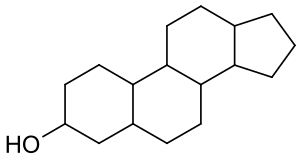Sterol
Sterols, also known as steroid alcohols, are a subgroup of the steroids and an important class of organic molecules. They are a type of lipid. They occur naturally in plants, animals, and fungi, and can be also produced by some bacteria (however likely with different functions).[1] The most familiar type of animal sterol is cholesterol, which is vital to cell membrane structure, and functions as a precursor to fat-soluble vitamins and steroid hormones.

Types
Sterols of plants are called phytosterols and sterols of animals are called zoosterols. The most important zoosterol is cholesterol; notable phytosterols include campesterol, sitosterol, and stigmasterol. Ergosterol is a sterol present in the cell membrane of fungi, where it serves a role similar to cholesterol in animal cells.
Role in biochemistry
Sterols and related compounds play essential roles in the physiology of eukaryotic organisms. For example, cholesterol forms part of the cellular membrane in animals, where it affects the cell membrane's fluidity and serves as secondary messenger in developmental signaling. In humans and other animals, corticosteroids such as cortisol act as signaling compounds in cellular communication and general metabolism. Sterols are common components of human skin oils.[2]
Phytosterols as a nutritional supplement
Phytosterols, more commonly known as plant sterols, have been shown in clinical trials to block cholesterol absorption sites in the human intestine, thus helping to reduce cholesterol absorption in humans.[3] They are currently approved by the U.S. Food and Drug Administration for use as a food supplement; however, there is some concern that they may block absorption not only of cholesterol, but of other important nutrients as well. At present, the American Heart Association has recommended that supplemental plant sterols be taken only by those diagnosed with elevated cholesterol, and has particularly recommended that they not be taken by pregnant women or nursing mothers.[4] Preliminary research has shown that phytosterols may have anticancer effects. [5]
Chemical classification and structure
Sterols are a subgroup of steroids with a hydroxyl group at the 3-position of the A-ring.[6] They are amphipathic lipids synthesized from acetyl-coenzyme A via the HMG-CoA reductase pathway. The overall molecule is quite flat. The hydroxyl group on the A ring is polar. The rest of the aliphatic chain is non-polar.
References
- Wei JH, Yin X, Welander PV (24 June 2016). "Sterol Synthesis in Diverse Bacteria". Front. Microbiol. 7: 990. doi:10.3389/fmicb.2016.00990. PMC 4919349. PMID 27446030.
- Lampe, M.A.; A.L. Burlingame; J. Whitney; M.L. Williams; B.E. Brown; E. Roitman; M. Elias (1983). "Human stratum corneum lipids: characterization and regional variations". J. Lipid Res. 24 (2): 120–130. PMID 6833889.
- Ostlund RE, Racette SB, Stenson WF (1 June 2003). "Inhibition of cholesterol absorption by phytosterol-replete wheat germ compared with phytosterol-depleted wheat germ". Am. J. Clin. Nutr. 77 (6): 1385–9. doi:10.1093/ajcn/77.6.1385. PMID 12791614.
- "Do healthy people need to eat plant sterols?". Medical News Today. 2004-11-04. Retrieved 2008-12-08.
- Bradford, P. G.; Awad, A. B. (February 2007). "Phytosterols as anticancer compounds". Molecular Nutrition & Food Research. 51 (2): 161–70. doi:10.1002/mnfr.200600164. PMID 17266177.
- Fahy E, Subramaniam S, Brown HA, et al. (2005). "A comprehensive classification system for lipids". J. Lipid Res. 46 (5): 839–61. doi:10.1194/jlr.E400004-JLR200. PMID 15722563.
Further reading
- Alberts, Bruce (2002). "10. Membrane Structure" (Online at NIH). Molecular biology of the cell. IV. Internal Organization of the Cell. New York: Garland Science. p. 1874. ISBN 978-0-8153-4072-0.
The Fluidity of a Lipid Bilayer Depends on Its Composition